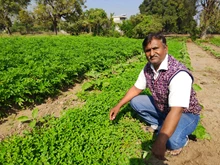
A project aimed at improving the health of India's holy river, the Ganges, is among ten "ground-breaking" efforts recognized by the United Nations for their role in restoring the natural world, according to a report released on Tuesday during the UN Biodiversity Conference (COP15) here.
The initiatives have been designated World Restoration Flagships and are eligible for UN-backed promotion, advice, and funding. They were chosen as part of the United Nations Decade on Ecosystem Restoration, a global movement coordinated by the United Nations Environment Programme (UNEP) and the United Nations Food and Agriculture Organization (FAO). According to the UN, it is intended to prevent and reverse the degradation of natural spaces worldwide.
According to the UN, the ten flagship projects aim to restore more than 68 million hectares- an area larger than Myanmar, France, or Somalia- and create nearly 15 million jobs. "Changing our relationship with nature is the key to reversing the triple planetary crisis of climate change, loss of nature and biodiversity, pollution, and waste," UNEP Executive Director Inger Andersen said. "With political will, science, and cross-border collaboration, we can achieve the goals of the UN Decade of Ecosystem Restoration and forge a more sustainable future not only for the planet but also for those of us who call it home," Andersen said here.
The UN said in a statement that restoring the Ganges' health is the focus of a major push to cut pollution, rebuild forest cover, and bring a wide range of benefits to the 520 million people who live around its vast basin. Climate change, population growth, industrialization, and irrigation have all degraded the Ganges along its 2,525-kilometer path from the Himalayas to the Bay of Bengal, according to the report.
"The government-led Namami Gange initiative, launched in 2014, is rejuvenating, protecting, and conserving the Ganges and its tributaries, reforesting parts of the Ganges basin, and promoting sustainable farming," according to the statement. The project also aims to reintroduce endangered wildlife species such as river dolphins, softshell turtles, otters, and hilsa shad fish. So far, 230 organizations have participated in the initiative, which has resulted in the restoration of 1,500 kilometres of the river.
Furthermore, according to the UN, there have been 30,000 hectares of afforestation, with a 2030 goal of 134,000 hectares. The Trinational Atlantic Forest Pact aims to protect and restore the forest in Brazil, Paraguay, and Argentina. The other inaugural World Restoration Flagship is the Abu Dhabi Marine Restoration project protecting the world's second-largest dugong population in Abu Dhabi.
The Multi-Country Mountain Initiative based in Serbia, Kyrgyzstan, Uganda, and Rwanda, as well as the Small Island Developing States Restoration Drive, focused on three small island developing states - Vanuatu, St Lucia, and Comoros - were also recognized. Other projects on the list included Kazakhstan's Altyn Dala Conservation Initiative to restore steppe, semi-desert, and desert ecosystems, the Central American Dry Corridor, and China's Shan-Shui Initiative.
The UN Decade on Ecosystem Restoration seeks to honour the best examples of large-scale and long-term ecosystem restoration that embody the 10 Restoration Principles of the UN Decade on Ecosystem Restoration by revealing the World Restoration Flagships. The UN Decade recognizes the time required for restoration efforts to yield results. Regular calls for World Restoration Flagships will be issued until 2030.
Additional submissions are being considered in anticipation of increased funding to the UN Decade's Multi-Partner Trust Fund (MPTF), including restoration drives from Pakistan, Peru, and a Somalia-focused initiative. Leaders and negotiators from 196 countries, including India, gathered here in Canada for a two-week conference expected to adopt a landmark agreement to halt and reverse nature loss by 2030. Approximately 20,000 delegates worldwide will negotiate an eight-year plan to preserve and restore biodiversity at the UN Biodiversity Conference (COP15) from December 7 to 19.
They will do so through the Convention on Biological Diversity, a treaty established to conserve and sustain biological diversity and related issues. The goal of COP15 is to reach a historic agreement to halt and reverse environmental degradation, similar to the 2015 Paris Climate Agreement. What is agreed upon in Montreal will essentially be a global blueprint for preserving the world's dwindling biodiversity.











